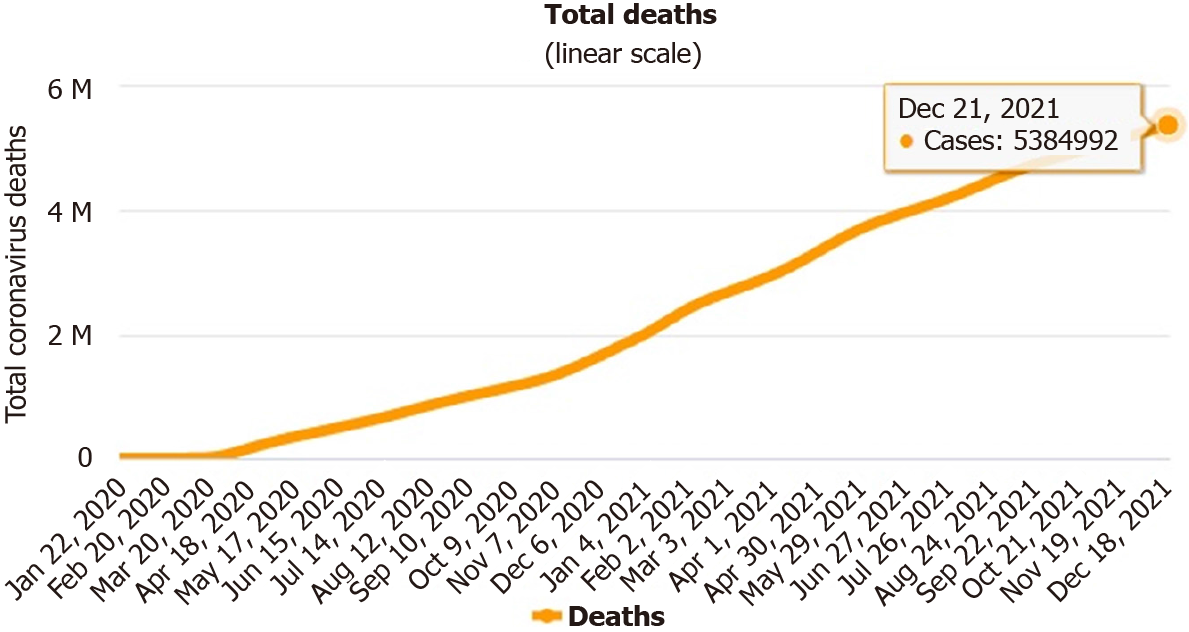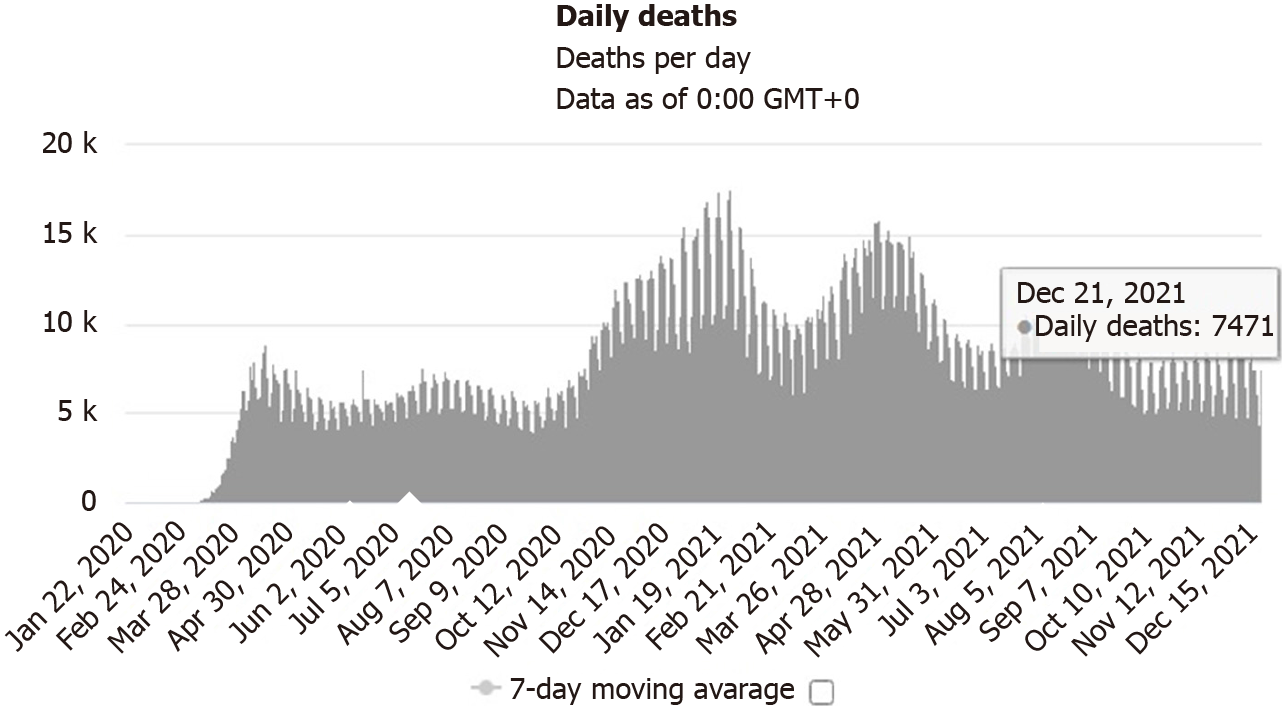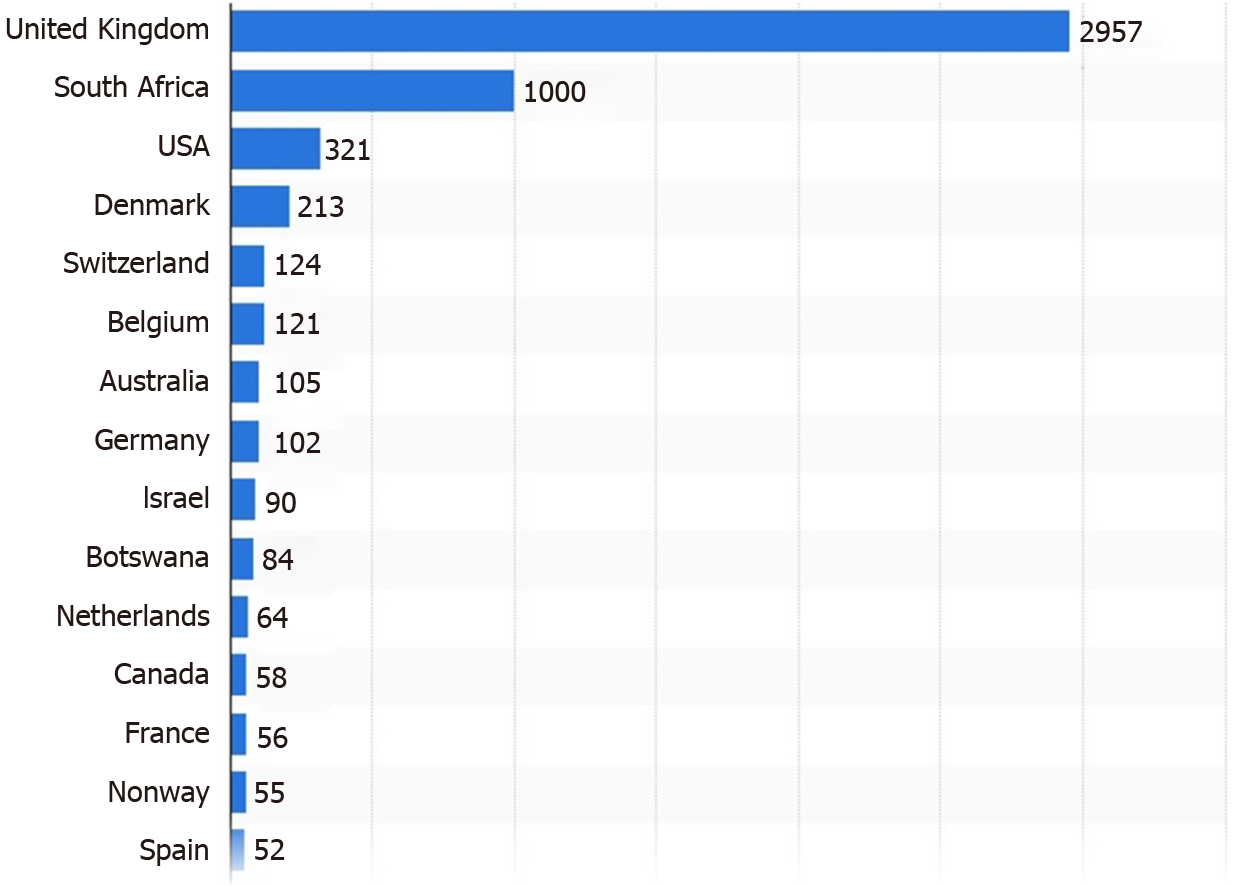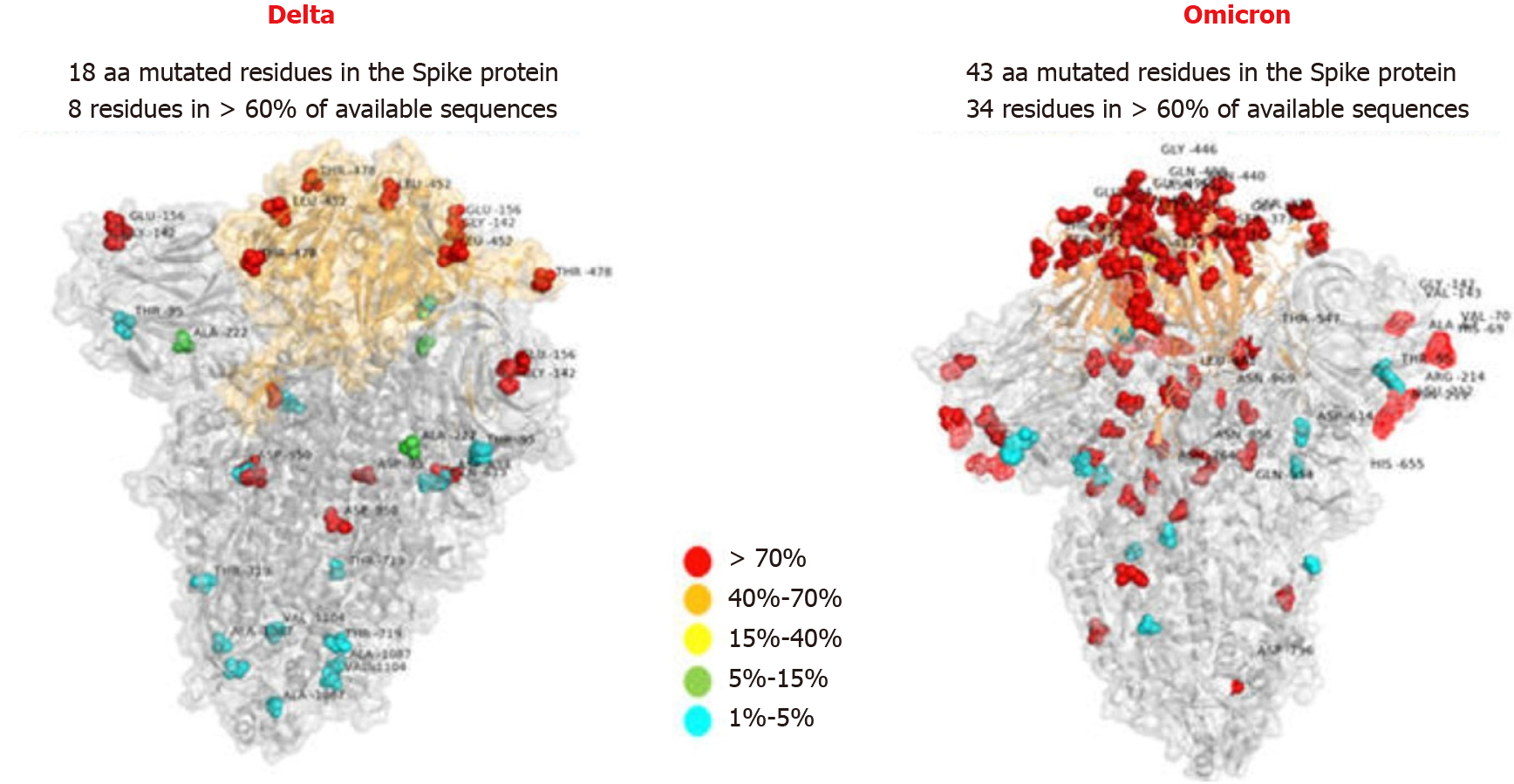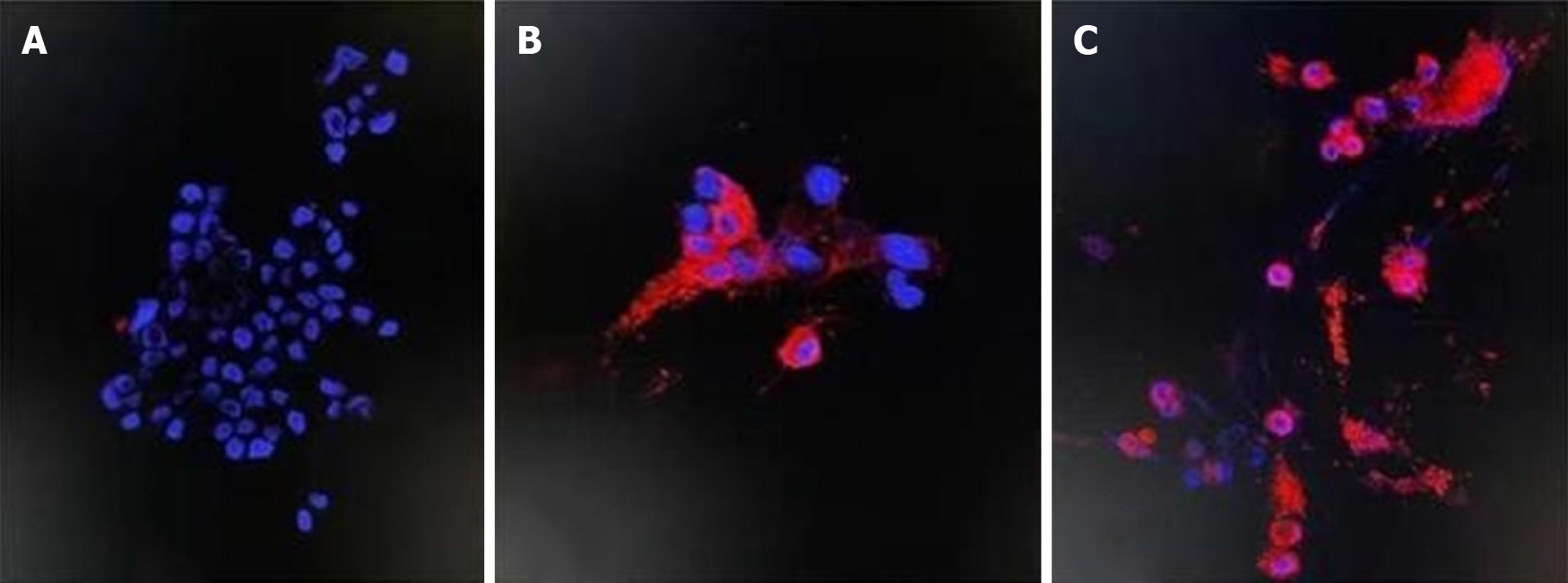Published online Jan 7, 2022. doi: 10.12998/wjcc.v10.i1.1
Peer-review started: December 8, 2021
First decision: December 13, 2021
Revised: December 16, 2021
Accepted: December 24, 2021
Article in press: December 24, 2021
Published online: January 7, 2022
Processing time: 21 Days and 17.7 Hours
The appearance of severe acute respiratory syndrome coronavirus 2 (SARS-CoV-2) variant Omicron (B.1.1.529) has caused panic responses around the world because of its high transmission rate and number of mutations. This review summarizes the highly mutated regions, the essential infectivity, transmission, vaccine breakthrough and antibody resistance of the Omicron variant of SARS-CoV-2. The Omicron is highly transmissible and is spreading faster than any previous variant, but may cause less severe symptoms than previous variants. The Omicron is able to escape the immune system’s defenses and coronavirus disease 2019 vaccines are less effective against the Omicron variant. Early careful preventive steps including vaccination will always be key for the suppression of the Omicron variant.
Core Tip: The Omicron variant is highly transmissible and is spreading faster than any previous variant, but causes less severe symptoms than previous variants. The Omicron is able to escape the immune system’s defenses and coronavirus disease 2019 vaccines are less effective against the Omicron variant. Early careful preventive steps including vaccination will be the key to the suppression of the Omicron variant.
- Citation: Ren SY, Wang WB, Gao RD, Zhou AM. Omicron variant (B.1.1.529) of SARS-CoV-2: Mutation, infectivity, transmission, and vaccine resistance. World J Clin Cases 2022; 10(1): 1-11
- URL: https://www.wjgnet.com/2307-8960/full/v10/i1/1.htm
- DOI: https://dx.doi.org/10.12998/wjcc.v10.i1.1
At the end of 2019, severe acute respiratory syndrome coronavirus 2 (SARS-CoV-2), the etiological agent of coronavirus disease 2019 (COVID-19), was first reported in Wuhan, China. Since then, it has become a pandemic globally, and has affected at least 222 countries and territories in the world[1-6]. The massive COVID-19 waves induced by the original SARS-CoV-2, the Beta, the Delta and the Omicron variants have lead to a horrible medical and economic disaster for the world[7,8]. As of December 21, 2021, 276570945 people have been infected with SARS-CoV-2 and 5384992 have lost their lives globally; the daily new confirmed case load is 748277 and the daily death rate was is 7471 on December 21, 2021 (Figures 1, 2, 3, and 4)[3,8].
The Omicron was first detected in Botswana and South Africa and is spreading quickly across South Africa and all over the world. As of December 16, 2021, it is in five continents including Europe, North America, Asia, South America, Africa and Oceania, and at least 77 countries including the United States, the United Kingdom, France, Germany, Australia, Japan, and China have all reported Omicron cases[3,8,9]. At least 44 countries have restricted travel to and from South Africa. This sounds an alarm for many countries and regions worldwide, causing fear and uncertainty in the global fight against the COVID-19 pandemic[10-12]. The appearance of the Omicron is another blow for the already struggling global economy, and certainly will add more uncertainties to all of us globally[8,10,11,13].
Many mutations in variants such as Delta and Alpha are associated with immune escape and the potential for higher transmissibility. However, considerable uncertainties with the Omicron are transmissibility, severity and pathogenicity of the Omicron, and the effect of the vaccines protection against the Omicron infection[2,14-16].
Publications harboring keywords COVID-19, Omicron variant (B.1.1.529), SARS-CoV-2, infectivity, transmission, genotyping, RT-PCR and variant of concern have been searched using the following databases or search engines: PubMed, MEDLINE, EMBASE, Web of Science, ScienceDirect, Cochrane Library and Google scholar, etc. All reports relating to Omicron variant B.1.1.529 were included. This review discusses the current status of the Omicron in terms of its mutations, infectivity, transmission and vaccine resistance and provides up-to-date information on the newly emerging SARS-CoV-2 Omicron variant.
The first known confirmed B.1.1.529 infection was from a specimen collected on November 9, 2021. A private lab, Lancet Laboratories in South Africa, had noticed that routine polymerase chain reaction (PCR) tests for SARS-CoV-2 failed to detect the S gene, a key target in many virus samples, and found out that the genome was too heavily mutated to test the missed gene after sequencing another eight viruses. Then Lancet shared the genomes with the Network for Genomics Surveillance in South Africa that called an urgent meeting on November 23, 2021. Another 100 randomly selected sequences from Gauteng were performed and resulted in the same pattern. The Omicron variant was first identified from an immunocompromised patient in South Africa and reported to the World Health Organization (WHO) from South Africa on November 24, 2021. On November 26, 2021, WHO designated the variant B.1.1.529 virus a “variant of concern” (VOC) and christened it the Omicron[16]. The current WHO list of VOC includes Alpha, Beta, Gamma, Delta and the Omicron. The variant names follow the Greek alphabet, but WHO skipped the letters Nu and Xi, because Nu is too easily confounded with ‘new’ and Xi was not used as it is a common surname. The Omicron VOC has dozens of mutations that may impact its infectivity and transmission[16]. As of December 16, 2021, the United Kingdom had reported the highest number of SARS-CoV-2 Omicron variant cases with about 2957. South Africa followed with 1000 cases including their President who was Omicron positive (Figure 5)[11,16].
The Omicron VOC clearly is not a direct descendant of the Delta strains or earlier variants of concern. Instead, it appears to have evolved in parallel[13], and is different from publicly shared SARS-CoV-2 genomes and hence it is hard to predict its closest relative. It likely diverged early from other strains[13]. The Omicron VOC could have circulated and evolved in a single immunocompromised human patient or a chronically infected COVID-19 patient over weeks or months with little surveillance. Or it might have evolved in a nonhuman species, from which it recently spilt back into the human[13].
When Alpha was first discovered in late 2020, it appeared to have acquired numerous mutations all at once, leading researchers to postulate a chronic infection. Researchers suspect that the Omicron’s rise may be largely due to its ability to infect people who are immune to Delta through vaccination or previous infection[17]. The Omicron cases in some countries were found to have no association with South Africa, hinting it could have already been spreading wider and went undetected elsewhere[10].
All viruses’ genomes gain mutations over time; RNA virus genomes are highly susceptible to mutation. Nevertheless, the mutation rate and the effects of mutation on viral dynamics within and between individual hosts, impact the rate of mutation and its reaction for transmission and disease in the host. All these variables determine the development and transmission of viral variations and the evolution of pandemics[18].
The human immune system produces different antibodies to neutralize SARS-CoV-2; the most important antibodies can be simply divided into class 1, 2 and 3 that each targets a slightly different site on the spike protein of SARS-CoV-2. A mutation called E484K changes the shape of the site that class 2 antibodies recognize, making them less potent. The Omicron harbors E484A mutation in this site and similar changes in the sites for the other two classes of antibodies.
The Omicron’s spike proteins include the full-length trimer, the S1 subunit, the NTD, and the receptor-binding domain (RBD), and latch on to receptors on human cells and are the main target of the human immune responses[10]. The Omicron has more than 50 mutations, of which the virus’ spike protein has 26-35 amino acids that are different from the original SARS-CoV-2 virus or the Delta. One of the three target genes encoding for the spike protein is not detected, which is called S gene dropout or S gene target failure (SGTF), and can be detected in the three-target RT-PCR assay. Then, SGTF samples are sequenced for whole genome of the Omicron (Figure 6, Table 1)[10].
| Characteristic | Omicron (B.1.1.529) | Delta (B.1.617.2) |
| Country first found | South Africa | India |
| Time first reported | November 24, 2021 | December 5, 2020 |
| Mutation residues | 43 | 18 |
| Δ69-70S deletion | + | - |
| Transmissibility | 3-6 fold | 1 fold |
| R in Gauteng SA | > 2 | < 1 |
| Morbidity | Mild | Severe |
| Death | Rare | Common |
| Age of patients | Middle aged people | Children or elderly |
| Vaccine effect | 33% | 80% |
In addition, amino acids have disappeared in three places and new ones appeared in one place, a three-residue was deleted in the ORF1a region(also called NSP6), a three-amino-acid sequence is inserted at position 214; several changes around the furin cleavage site (S1-S2) are located around the RBD at the tip of the spike that contacts with the human cell. Only two in the region coding for the N protein (the nucleocapsid) may be associated with higher viral loads. Structural biology mapping in 2020 showed some of these changes help the virus bind to the receptor much better[16].
An epidemic’s growth is measured by R to show the average number of new cases caused by each infection. The R value was less than 1 in September when Delta prevailed and the number of cases was dropping, however, in late November the R value reached above 2 in Gauteng, South Africa. According to the growing number of cases and the sequencing data, the Omicron is estimated to infect three to six times as many people as Delta over the same time[11]. Current data shows that Omicron VOC is highly transmissible, spreading several times faster than any previous variant. It had been reported in 77 countries by December 15, 2021 and is likely to be in most countries because it has not been detected yet. Omicron infects people who are immune to other variants[6,11,19-21].
In South Africa, the Omicron variant has overtaken Delta as the predominant lineage and there is almost a vertical spike of Omicron infection. The country is not seeing severe hospitalizations yet. The reinfection risk profile of the Omicron is much higher than that of other variants[10]. In November the Omicron cases spread rapidly in Gauteng province, particularly in schools and among young people. The B.1.1.529 variant was detected from all 77 of the virus samples collected from Gauteng between November 12, 2021 and November 20, 2021. Among 249 genome sequences performed in South Africa after November 25, 183 were positive for the Omicron VOC[10]. South Africa recorded 3402 cases on November 26, 2021 and 8561 cases on December 1, 2021 and several hundred cases per day were recorded in mid-November[11]. A recent analysis of 35670 reinfections among nearly 2.8 million positive tests in South Africa suggests dozens of mutations in the Omicron might help it evade immunity[4,13].
The Omicron VOC had been present in the Netherlands before it was detected in Southern Africa. The Dutch health authority had stated cases dating from November 19, 2021 and November 23, 2021[5]. Japan confirmed their first case of the Omicron VOC from a Namibian diplomat who tested positive for the COVID-19 at the Narita airport near Tokyo upon his arrival. On November 26, 2021, Belgium reported their first Omicron case in Europe; two Omicron cases were reported in Germany by travelers entering the Munich Airport on November 24, 2021. In Norway, health authorities reported Omicron infections will increase to 300000 people a day from the previous strain's record of 1000 a day. Cases are also skyrocketing in Switzerland[9,21,22].
In the United States, the first United States Omicron case was detected in San Francisco, California by a traveler returning from South Africa on November 22, 2021 and was identified on December 1, 2021[7]. Since shedding of SARS-CoV-2 in patient stool is frequent, the Omicron VOC was detected in a sample of wastewater collected in Merced Sacramento County on November 25, 2021[22]. At least 31 states in the United States and Washington DC have identified Omicron variant cases as of December 15, 2021[21,22]. The US has accounted for 3% coronavirus cases, an increase from the previous week of 0.4%, the first Omicron death was reported on December 20, 2021 and Omicron is likely to become a dominant COVID-19 variant in the United States[21].
In the United Kingdom, on November 27, 2021, two Omicron cases of travelers who had been to South Africa were found. Recently the Omicron B.1.1.529 variant infections have increased more steeply and widely than the Delta strain and are likely to replace it as the dominant strain in Britain within days. Omicron represents more than 1 in 5 coronavirus cases and is now infecting 200000 people a day. The number of Omicron cases is doubling every 2 d to 3 d[10,12,19]. On December 12, 2021, 1239 Omicron cases were found, bringing the total cases to 3137 in the United Kingdom. On December 15, 2021, 4671 Omicron cases had been confirmed in Britain, the biggest daily increase. The total Omicron cases found in the United Kingdom to this date was 10017. With at least 10 people hospitalized, the first Omicron death was reported on December 13, 2021, and 20 people died from the Omicron by December 20, 2021[8,9,20,21].
A traveler arriving in Hong Kong from South Africa had tested positive for the Omicron on November 25, 2021[23]. In China, the first Omicron case is a traveler who arrived in Tianjin from a European country on December 9, 2021 and the second case entered Guangzhou from overseas on November 27, 2021 when their test was negative, however, the test collected on December 12, 2021 turned positive with confirmation of Omicron variant[5,23].
Several vaccines have been developed and administered to neutralize the SARS-CoV-2 for therapeutic and prophylactic purposes. Current vaccines remain effective against severe disease and death including against the Delta variant and boosters reinforce the protection[11]. The partially and fully vaccinated cases are highly protected against hospitalization associated with Delta or Alpha[23]. Analysis data in Canada showed agreater than 80% protection against hospitalization[12]. The Omicron variant reduces the effectiveness of the Pfizer-BioNTech's COVID-19 vaccine, but the vaccine can still lower the risk of hospital admission[21].
The modest levels of neutralizing antibodies may protect people from severe forms of COVID-19[23]. Other aspects of the immune system, particularly T cells, may be less impacted by the Omicron’s mutations than are antibody responses. BioNTech and Pfizer claimed that two doses of the vaccine should still protect against severe disease because the surface structures on the Omicron’s spike protein is targeted by the T-cells, which typically emerge after vaccination, are not affected by the Omicron's mutations[24]. However, computer modeling indicates that B.1.1.529 could dodge immunity conferred by T cells. The polymutant spike was confirmed fully resistant to neutralizing antibodies from most cases being tested, who had received two doses of an mRNA vaccine or recovered from infection of COVID-19[12].
The Omicron might be able to evade immunity from vaccines or previous infections and blunts the potency of neutralizing antibodies more extensively than any other variant causing the existing vaccines to be less effective against the Omicron[6,4,19]. The study by Discovery Ltd, the largest private health insurer in South Africa, showed that Omicron reduced vaccine effectiveness against infection to 33% from 80% for Delta. The Pfizer-BioNTech vaccine's efficacy against severe illness and hospitalization falls to 70% from 93%. People infected with the Delta variant have a 40% relative risk of contracting the Omicron variant, while those infected with the Beta variant at the beginning of 2020 have a 60% chance of reinfection with Omicron[21]. In the United States as of December 10, 43 Omicron cases had been fully vaccinated, of whom 14 had received a booster dose, 5 cases occurred fewer than 14 d after the additional shot[21].
In South Africa, the Omicron causes more infections in people who have recovered from an earlier SARS-CoV-2 infection. In Oslo, all attendees were vaccinated and had tested negative, after attending a company Christmas party at a restaurant, at least 120 people were tested positive, and 19 Omicron cases had been confirmed. In Denmark, 53 of 150 high school students who attended a party were positive for the Omicron[4].
Virologist Alex Sigal and colleagues, at the African Health Research Institute in Durban, South Africa, reported that serum from 12 people who received the Pfizer-BioNtech vaccine was 40 times less potent against the Omicron than an earlier strain of SARS-CoV-2[6]. Virologist Daniel Sheward and Murrell also reported a smaller reduction in levels of the Omicron neutralizing antibodies in 17 healthcare workers previously infected, and 17 Swedish blood donors[6]. Furthermore, Dr. Madhi and colleagues found that the vaccine provided little protection against mild and moderate disease. People who had been injected by one of the three kinds of vaccines that are from Johnson & Johnson, Pfizer–BioNTech and Oxford–AstraZeneca in South Africa have been reported to get the Omicron infection. The regular two-dose mRNA cannot prevent the Omicron infection itself[9]. Two travelers in Hong Kong who tested positive for the Omicron had gottenthe Pfizer vaccine.
The serious key concern is disease severity. The Omicron VOC appears to be no worse than other coronavirus strains or even less severe than Delta[19]. Preliminary evidence suggests the risk of reinfection with the Omicron variant is higher than other variants. There are increasing rates of hospitalization in South Africa, most breakthrough infections with the Omicron and have less severe symptoms than previous variants[4]. The number who needed oxygen support was less than that in previous waves[4]. In the United States, among 43 Omicron cases with an initial follow-up, one hospitalization and no deaths were reported. The most commonly reported symptoms were cough, fatigue, and congestion or runny nose[7]. The Omicron might be less severe than its predecessors, but it is too early to tell whether the Omicron is really more benign[4,11].
Data in South Africa showed that vaccination might be effective to prevent severe illness caused by the Omicron VOC[10]. The preliminary results released by teams in South Africa, Germany, Sweden and the Pfizer-BioNtech collaboration indicate that protection provided by existing COVID-19 vaccines will not be totally lost. The boosters should strengthen immunity to the Omicron[6]. Third doses supercharge neutralizing-antibody levels, and this will likely provide a safeguard against the Omicron’s ability to evade the antibodies. Bieniasz and colleagues reported that patients recovered from SARS-CoV-2 infectionhad antibodies to block the mutant spike, indicating that people with repeated exposure to Omicron’s spike protein might have neutralizing activity against the Omicron[11].
The high level of natural population immunity after each variant in the South Africa wave hints that natural immunity does not last long enough to protect against the next variant[10]. Limited information indicates that patients with previous SARS-COV-2 infection could become reinfected more easily with the Omicron than with other variants. Around one-quarter of South Africa is fully vaccinated and many people were infected with SARS-CoV-2 in earlier waves. Callaway[6] found that people infected with SARS-CoV-2 previously prior to vaccination tended to have higher levels of neutralizing antibodies against the Omicron than vaccinated people with no infection of the Omicron.
The SARS-CoV-2 variants carrying the spike (S) deletion H69-V70 (ΔH69/ΔV70) and RBD mutations are screened with RT-PCR followed by whole genome sequencing[18]. This strategy allowed the first detection of the VOC 202012/01 co-occurring with ΔH69/ΔV70 including S: N501Y in France[18]. In practice, SARS-CoV-2 RNA is isolated from samples harboring SARS-CoV-2 and then converted to cDNA for further amplification using one-step real-time reverse transcription-PCR assay. In addition, single nucleotide polymorphism genotyping is a rapid, high-through output and low-cost alternative for screening positive SARS-CoV-2 samples in many settings and does not need to convert RNA to cDNA[25]. Alternatively, a light-up CRISPR-Cas13 tran
Lastly, in order to screen and identify human SARS-CoV-2 seroconversion, a serological enzyme-linked immunosorbent assay can be used to detect different antibody types in serum and plasma and does not require handling of infectious virus[27].
Current SARS-CoV-2 PCR diagnostics can pinpoint the potential Omicron cases for sequencing. The 69-70 deletion causes the PCR assay failure, which can be used as a marker helping to detect the Omicron VOC pending sequencing[10]. The Alpha (B.1.1.7) variant has a deletion of amino acids 69 and 70 in Alpha’s spike gene (Δ69-70), yielding a distinct absent S-gene (S-). The Delta variant lacks this deletion and is therefore S-gene positive (S+) on PCR tests. The Omicron variant shares the spike Δ69-70 deletion with Alpha, which has dropped to negligible levels. Therefore, the frequency of S- results can be used as a rapid proxy for the frequency of Omicron cases[28]. PCR assays provide broader coverage with a less biased view[16].
The Omicron variant can be cultured with cells and isolated for related research. Professor Guo-Yong Yuan and colleagues, Department of Biology, University of Hong Kong, isolated the Omicron variant from a confirmed Omicron case in Hong Kong on November 29, 2021 that can be used for further study of the Omicron[29] (Figure 7).
All variants of COVID-19 can cause severe disease or death, especially for the most vulnerable people, and thus prevention is always the key[1,16]. How well the Omicron VOC spreads depends on preventive steps such as vaccination. The number of infections will depend on how much the variant escapes protection from vaccines, and how effective booster shots are at bolstering immunity, unfortunately, both of which remain unclear, the vaccines alone are not strong enough to control the pandemic[9].
Therefore, the most effective approaches are to isolate the infected people, wear a proper mask, keep a physical distance of at least 1 meter from others, keep hands clean, open windows to improve ventilation, avoid poorly ventilated or crowded spaces, cough or sneeze into a bent elbow or tissue and get vaccinated especially for vulnerable groups such as health workers and elderly[1,16,19]. The pooled data from 16 randomized controlled trials, including 16236 COVID-19 patients treated with convalescent plasma[30] showed that convalescent plasma has no benefit in non-severe patients, hence WHO recommends against using convalescent plasma to treat COVID-19[30].
The Omicron VOC might have high infectivity, but causes less severe symptoms than previous variants, and is likely able to escape immunity. The existing vaccines are less effective against the fast-spreading Omicron VOC, but boosters should strengthen immunity. Early careful preventive steps including vaccination are always the key for suppression of the Omicron VOC.
Provenance and peer review: Invited article; Externally peer reviewed.
Peer-review model: Single blind
Specialty type: Biotechnology and applied microbiology
Country/Territory of origin: China
Peer-review report’s scientific quality classification
Grade A (Excellent): 0
Grade B (Very good): B, B
Grade C (Good): C, C, C
Grade D (Fair): 0
Grade E (Poor): 0
P-Reviewer: Afzal MS, Arumugam VA, Nakaji K, Samadder S S-Editor: Liu JH L-Editor: Filipodia P-Editor: Liu JH
| 1. | Ren SY, Gao RD, Chen YL. Fear can be more harmful than the severe acute respiratory syndrome coronavirus 2 in controlling the corona virus disease 2019 epidemic. World J Clin Cases. 2020;8:652-657. [RCA] [PubMed] [DOI] [Full Text] [Full Text (PDF)] [Cited by in CrossRef: 219] [Cited by in RCA: 157] [Article Influence: 31.4] [Reference Citation Analysis (2)] |
| 2. | Ren SY, Wang WB, Hao YG, Zhang HR, Wang ZC, Chen YL, Gao RD. Stability and infectivity of coronaviruses in inanimate environments. World J Clin Cases. 2020;8:1391-1399. [RCA] [PubMed] [DOI] [Full Text] [Full Text (PDF)] [Cited by in CrossRef: 161] [Cited by in RCA: 129] [Article Influence: 25.8] [Reference Citation Analysis (3)] |
| 3. | Worldometer. COVID-19 Coronavirus Pandemic. Last updated: December 19, 2021. Available from: https://www.worldometers.info/coronavirus/#countries. |
| 4. | Kupferschmidt K, Vogel G. How bad is Omicron? Science. 2021;374:1304-1305. [RCA] [PubMed] [DOI] [Full Text] [Cited by in Crossref: 29] [Cited by in RCA: 31] [Article Influence: 7.8] [Reference Citation Analysis (0)] |
| 5. | Graham F. Daily briefing: Omicron was already spreading in Europe. Nature. 2021;. [RCA] [PubMed] [DOI] [Full Text] [Cited by in Crossref: 8] [Cited by in RCA: 7] [Article Influence: 1.8] [Reference Citation Analysis (0)] |
| 6. | Callaway E. Omicron likely to weaken COVID vaccine protection. Nature. 2021;600:367-368. [RCA] [PubMed] [DOI] [Full Text] [Cited by in Crossref: 66] [Cited by in RCA: 109] [Article Influence: 27.3] [Reference Citation Analysis (1)] |
| 7. | Xinhua. Omicron variant detected in California's wastewater before WHO raises alarms: US media.China Daily. Updated: December 11, 2021. Available from: https://global.chinadaily.com.cn/a/202112/11/WS61b40bd4a310cdd39bc7abbf.html. |
| 8. | Xinhua. UK reports highest number of daily cases since start of COVID pandemic.China Daily. Updated: December 16, 2021. Available from: https://www.chinadaily.com.cn/a/202112/16/WS61ba7976a310cdd39bc7b987.html. |
| 9. | Xinhua. UK raises COVID-19 alert level amid rising Omicron cases. China Daily. Updated: December 13, 2021. Available from: https://www.chinadaily.com.cn/a/202112/13/WS61b6a5d4a310cdd39bc7aea3.html. |
| 11. | Callaway E, Ledford H. How bad is Omicron? Nature. 2021;600:197-199. [RCA] [PubMed] [DOI] [Full Text] [Cited by in Crossref: 128] [Cited by in RCA: 173] [Article Influence: 43.3] [Reference Citation Analysis (4)] |
| 12. | Graham F. Daily briefing: Omicron coronavirus variant puts scientists on alert. Nature. 2021;. [RCA] [PubMed] [DOI] [Full Text] [Cited by in Crossref: 16] [Cited by in RCA: 15] [Article Influence: 3.8] [Reference Citation Analysis (0)] |
| 13. | Kupferschmidt K. Where did 'weird' Omicron come from? Science. 2021;374:1179. [RCA] [PubMed] [DOI] [Full Text] [Cited by in Crossref: 90] [Cited by in RCA: 95] [Article Influence: 23.8] [Reference Citation Analysis (1)] |
| 14. | World Health Organization. Assays & Animal Models - Outline of research priorities related to the Omicron variant. 29 November 2021. Available from: https://www.who.int/publications/m/item/assays-animal-models---outline-of-research-priorities-related-to-the-omicron-variant. |
| 15. | World Health Organization. Enhancing Readiness for Omicron (B.1.1.529): Technical Brief and Priority Actions for Member States. November 28, 2021. Available from: https://www.who.int/publications/m/item/enhancing-readiness-for-omicron-(b.1.529)-technical-brief-and-priority-actions-for-member-states. |
| 16. | World Health Organization. Update on Omicron. November 28, 2021. Available from: https://www.who.int/news/item/28-11-2021-update-on-omicron. |
| 17. | Callaway E. Beyond Omicron: what's next for COVID's viral evolution. Nature. 2021;600:204-207. [RCA] [PubMed] [DOI] [Full Text] [Cited by in Crossref: 69] [Cited by in RCA: 115] [Article Influence: 28.8] [Reference Citation Analysis (0)] |
| 18. | Bal A, Destras G, Gaymard A, Stefic K, Marlet J, Eymieux S, Regue H, Semanas Q, d'Aubarede C, Billaud G, Laurent F, Gonzalez C, Mekki Y, Valette M, Bouscambert M, Gaudy-Graffin C, Lina B, Morfin F, Josset L; COVID-Diagnosis HCL Study Group. Two-step strategy for the identification of SARS-CoV-2 variant of concern 202012/01 and other variants with spike deletion H69-V70, France, August to December 2020. Euro Surveill. 2021;26. [RCA] [PubMed] [DOI] [Full Text] [Full Text (PDF)] [Cited by in Crossref: 156] [Cited by in RCA: 153] [Article Influence: 38.3] [Reference Citation Analysis (0)] |
| 19. | China Daily Global. Experts: Omicron likely no worse than other variants. 15 Dec, 2021P7. Available from: https://epaper.chinadaily.com.cn/a/202112/09/WS61b13202a31019b029ba2661.html. |
| 20. | Gale E. Lawmakers mull Plan B rules. China Daily Global.15 Dec, 2021. Available from: https://global.chinadaily.com.cn/a/202112/15/WS61b942fca310cdd39bc7b619.html. |
| 21. | Zhang M. Omicron now accounts for 3% of US coronavirus cases. China Daily Global. 15 Dec 2021. Available from: https://global.chinadaily.com.cn/a/202112/15/WS61b95f63a310cdd39bc7b7f8.html. |
| 22. | Xinhua. Omicron variant detected in California's wastewater before WHO raises alarms: US media. China Daily. December 11, 2021. Available from: https://global.chinadaily.com.cn/a/202112/11/WS61b40bd4a310cdd39bc7abbf.html. |
| 23. | Veneti L, Salamanca BV, Seppälä E, Starrfelt J, Storm ML, Bragstad K, Hungnes O, Bøås H, Kvåle R, Vold L, Nygård K, Buanes EA, Whittaker R. No difference in risk of hospitalisation between reported cases of the SARS-CoV-2 Delta variant and Alpha variant in Norway. Int J Infect Dis. 2021;. [RCA] [PubMed] [DOI] [Full Text] [Full Text (PDF)] [Cited by in Crossref: 16] [Cited by in RCA: 26] [Article Influence: 6.5] [Reference Citation Analysis (0)] |
| 24. | Zhang M. Pfizer: Booster protects against Omicron. China Daily Global. December 9, 2021. Available from: https://www.chinadaily.com.cn/a/202112/09/WS61b1141aa310cdd39bc7a2d8.html. |
| 25. | Harper H, Burridge A, Winfield M, Finn A, Davidson A, Matthews D, Hutchings S, Vipond B, Jain N; COVID-19 Genomics UK (COG-UK) Consortium, Edwards K, Barker G. Detecting SARS-CoV-2 variants with SNP genotyping. PLoS One. 2021;16:e0243185. [RCA] [PubMed] [DOI] [Full Text] [Full Text (PDF)] [Cited by in Crossref: 53] [Cited by in RCA: 44] [Article Influence: 11.0] [Reference Citation Analysis (0)] |
| 26. | Wang Y, Zhang Y, Chen J, Wang M, Zhang T, Luo W, Li Y, Wu Y, Zeng B, Zhang K, Deng R, Li W. Detection of SARS-CoV-2 and Its Mutated Variants via CRISPR-Cas13-Based Transcription Amplification. Anal Chem. 2021;93:3393-3402. [RCA] [PubMed] [DOI] [Full Text] [Full Text (PDF)] [Cited by in Crossref: 110] [Cited by in RCA: 122] [Article Influence: 30.5] [Reference Citation Analysis (0)] |
| 27. | Amanat F, Stadlbauer D, Strohmeier S, Nguyen THO, Chromikova V, McMahon M, Jiang K, Arunkumar GA, Jurczyszak D, Polanco J, Bermudez-Gonzalez M, Kleiner G, Aydillo T, Miorin L, Fierer DS, Lugo LA, Kojic EM, Stoever J, Liu STH, Cunningham-Rundles C, Felgner PL, Moran T, García-Sastre A, Caplivski D, Cheng AC, Kedzierska K, Vapalahti O, Hepojoki JM, Simon V, Krammer F. A serological assay to detect SARS-CoV-2 seroconversion in humans. Nat Med. 2020;26:1033-1036. [RCA] [PubMed] [DOI] [Full Text] [Cited by in Crossref: 1452] [Cited by in RCA: 1379] [Article Influence: 275.8] [Reference Citation Analysis (2)] |
| 28. | Scott L, Hsiao NY, Moyo S, Singh L, Tegally H, Dor G, Maes P, Pybus OG, Kraemer MUG, Semenova E, Bhatt S, Flaxman S, Faria NR, de Oliveira T. Track Omicron's spread with molecular data. Science. 2021;374:1454-1455. [RCA] [PubMed] [DOI] [Full Text] [Cited by in Crossref: 73] [Cited by in RCA: 73] [Article Influence: 18.3] [Reference Citation Analysis (0)] |
| 29. | The Paper. University of HK isolated the Omicron variant.December,2021. Available from: https://m.thepaper.cn/baijiahao_15655744. |
| 30. | World Health Organization. WHO recommends against the use of convalescent plasma to treat COVID-19. Dec 7, 2021. Available from: https://www.who.int/news/item/07-12-2021-who-recommends-against-the-use-of-convalescent-plasma-to-treat-covid-19. |










